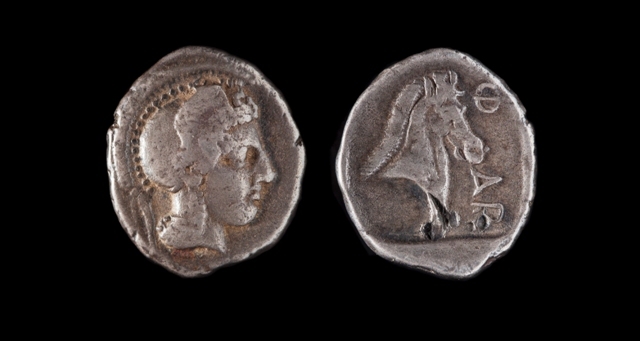Pharsalos, Thessaly, Silver Hemidrachm
Dublin Core
Title
Pharsalos, Thessaly, Silver Hemidrachm
Subject
Pharsalos, Thessaly (Greece). Silver Hemidrachm (Triobol), 440-425 BCE.
OBVERSE: Head of Athena with earrings facing right, wearing a crested Attic helmet with raised cheek guards.
REVERSE: Horse protome in incuse square facing right. In right field, inscription "F-AR" with Archaic Greek R (short for: Pharsalon, "of the Pharsalians"; test cut on base of horse head.
OBVERSE: Head of Athena with earrings facing right, wearing a crested Attic helmet with raised cheek guards.
REVERSE: Horse protome in incuse square facing right. In right field, inscription "F-AR" with Archaic Greek R (short for: Pharsalon, "of the Pharsalians"; test cut on base of horse head.
Description
Though never mentioned in Homeric epic, Thessaly claimed its founder was none other than Aiakos, the grandfather of Achilles, making it the Homeric Phthia, also the birthplace of Achilles.
Later in time, probably around 60 CE, Thessaly was commemorated in Lucan’s famous epic poem, Pharsalia. This poem accounts the defeat of Pompey and the forces of the Roman Republic by Julius Caesar in the battle of Pharsalos, which took place in 48 BCE.
This coin was minted during the golden age of Thessaly, under the reign of ruler Daochos (ca. 441 - 413 BCE). Athena is shown on the obverse wearing an Attic helmet. This might seem a bit odd since it does not provide as much protection as the more contemporary Corinthian helmet. Some scholars have suggested that this Athena is specifically referring to the city’s patron goddess, Athena Polias, who may have been depicted wearing an Attic helmet.
The horse on the back is an allusion to the illustrious status of Thessalian horses and the prestige of the cavalry. Alexander the Great’s legendary horse, Bucephalus, was a Thessalian horse.
Later in time, probably around 60 CE, Thessaly was commemorated in Lucan’s famous epic poem, Pharsalia. This poem accounts the defeat of Pompey and the forces of the Roman Republic by Julius Caesar in the battle of Pharsalos, which took place in 48 BCE.
This coin was minted during the golden age of Thessaly, under the reign of ruler Daochos (ca. 441 - 413 BCE). Athena is shown on the obverse wearing an Attic helmet. This might seem a bit odd since it does not provide as much protection as the more contemporary Corinthian helmet. Some scholars have suggested that this Athena is specifically referring to the city’s patron goddess, Athena Polias, who may have been depicted wearing an Attic helmet.
The horse on the back is an allusion to the illustrious status of Thessalian horses and the prestige of the cavalry. Alexander the Great’s legendary horse, Bucephalus, was a Thessalian horse.
Source
Gift of James and Aneta McIntyre, Hallie Ford Museum of Art, Salem, OR. 2006.010.007
Date
ca. 441 - 413 BCE
Rights
Hallie Ford Museum of Arts
Format
1.360 cm
2.900 gr
2.900 gr
Language
Greek
Type
Coin
Identifier
Thessalian horse
Coverage
This item can be viewed on the Hallie Ford Museum of Art's website
Citation
“Pharsalos, Thessaly, Silver Hemidrachm,” Hallie Ford Museum of Art Exhibits, accessed January 8, 2026, https://library.willamette.edu/hfma/omeka/items/show/58.
